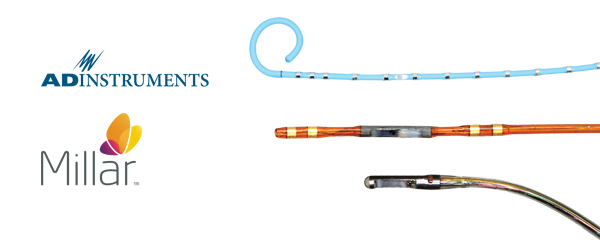Millar Mikro-Tip® solid state catheters are the world’s most accurate physiological pressure catheters, providing sensitive and reliable measurement of small pressure changes with high fidelity.
Below we have outlined some unique intracranial pressure research applications using Mikro-Tip® catheters, plus some applications that utilize simultaneous catheter recordings in multiple systems. Optimized for use in intracranial, interstitial, intrauterine, intradiscal, and arterial blood pressures, you can be confident in the data being recorded from various sources throughout experimentation.
Millar Catheters - Intracranial Pressure Applications:
Cardiopulmonary Resuscitation (CPR)
Experimentally assessing CPR methods requires the use of multiple sites for pressure recordings. It’s important to assess not only pressure fluctuations throughout the body but how those fluctuations coincide. Reliable tools are critical. Millar Mikro-Tip® catheters measure directly from the pressure site, producing highly accurate and reproducible recordings.

CPR variations are commonly tested on larger animals to reflect the treatment viability for humans. Pressure measurements are taken from multiple systems simultaneously to assess those interacting pressure systems and figure out what a pressure change in one system means for pressure in another.
Intracranial pressure can be measured via the epidural space, subdural space, or directly from the tissue of the brain using the MPR-500 or SPR-751S. Meanwhile, aortic blood pressure can be recorded via the femoral artery, and veinous blood pressure can be recorded via the external jugular veins using the SPR-350 or SPR-751. Finally, intrapleural pressure can be measured by inserting a Mikro-Tip® catheter into the intrapleural space with either the MPR-500 or SPR-751S. This broad approach ensures simultaneous measurement of intracranial, cardiovascular, and intrapleural pressures for a complete overview of the impact of CPR methods.
Publications:
- Kwon, Younghoon, et al. “Effect of Regulating Airway Pressure on Intrathoracic Pressure and Vital Organ Perfusion Pressure during Cardiopulmonary Resuscitation: A Non-Randomized Interventional Cross-over Study.” Scandinavian Journal of Trauma, Resuscitation and Emergency Medicine, vol. 23, no. 1, 2015.
- Moore, Johanna C., et al. “Head and Thorax Elevation during Active Compression Decompression Cardiopulmonary Resuscitation with an Impedance Threshold Device Improves Cerebral Perfusion in a Swine Model of Prolonged Cardiac Arrest.” Resuscitation, vol. 121, 2017, pp. 195–200.
- Moore, Johanna C., Joe Holley, et al. “Consistent Head up Cardiopulmonary Resuscitation Haemodynamics Are Observed across Porcine and Human Cadaver Translational Models.” Resuscitation, vol. 132, 2018, pp. 133–39.
- Ryu, Hyun Ho, et al. “The Effect of Head Up Cardiopulmonary Resuscitation on Cerebral and Systemic Hemodynamics.” Resuscitation, vol. 102, 2016, pp. 29–34.
Brain Injury
Brain injuries can take many forms, from sports-related concussions to hemorrhages and strokes to traumatic brain injuries from impact. To best treat a brain injury when it occurs, we need to clearly understand what happens inside the brain as the injury progresses.
![]()
Real-time reliable pressure monitoring is crucial to understanding the moment-to-moment changes in brain injury. Minute fluctuations in intracranial pressure can provide critical information about brain damage, cell death, injury severity, and risk of further complications. This importance is highlighted in Everitt et al., with the researchers examining the impact of different forms of brain injury on ICP. In this case, Everitt et al. were attempting to identify changes that could tip them off to a possible secondary brain injury following the initial injury. Everitt et al. used the high-quality ICP signal provided by the Millar Mikro-Tip® catheter, in conjunction with bioimpedance monitoring, to better identify possible secondary brain injuries following the initial injury.
Publications:
- Everitt, Alicia, et al. “A Bioimpedance-Based Monitor for Real-Time Detection and Identification of Secondary Brain Injury.” Scientific Reports, vol. 11, no. 1, 2021.
- Golanov, Eugene V., et al. “Subarachnoid Hemorrhage – Induced Block of Cerebrospinal Fluid Flow: Role of Brain Coagulation Factor III (Tissue Factor).” Journal of Cerebral Blood Flow & Metabolism, vol. 38, no. 5, 2017, pp. 793–808.
- Metzger, Anja, et al. “Intrathoracic Pressure Regulation Improves Cerebral Perfusion and Cerebral Blood Flow in a Porcine Model of Brain Injury.” Shock, vol. 44, no. Supplement 1, 2015, pp. 96–102.
Hydrocephalus
Hydrocephalus is an accumulation of cerebrospinal fluid in the brain. This accumulating fluid enlarges the lateral ventricles, putting pressure on the surrounding brain tissue and causing various complications from headaches to vomiting to coma. Many genes are associated with congenital hydrocephalus, but it’s not always clear how these genetic components result in CSF accumulation.
![]()
Duy et al.’s work highlights the importance of assessing direct pressure with a solid state Mikro-Tip® catheter. Using the SPR-1000, our smallest Mikro-Tip® catheter, Duy et al. worked to characterize a mouse model of hydrocephalus stemming from a specific genetic mutation. As they build this information around the changes in intracranial pressure, it is crucial that all of their data accurately reflects the ICP of the development model and not the result of nearby changes or recording artifacts. The reliability of a solid-state catheter ensures that the data gathered is characteristic of this particular mouse model.
Publications:
- Duy, Phan Q., et al. “Impaired Neurogenesis Alters Brain Biomechanics in a Neuroprogenitor-Based Genetic Subtype of Congenital Hydrocephalus.” Nature Neuroscience, vol. 25, no. 4, 2022, pp. 458–73.
- Xue, Yuechuan, et al. “Sustained Glymphatic Transport and Impaired Drainage to the Nasal Cavity Observed in Multiciliated Cell Ciliopathies with Hydrocephalus.” Fluids and Barriers of the CNS, vol. 19, no. 1, 2022.
Cerebral Perfusion
Relational pressure between distal, but connected, anatomical areas is of increasing interest, especially in the case of cerebral perfusion. The question of how to most effectively return blood flow to the brain after a cardiovascular event is complex but can be assessed in part by examining the relationship between intracranial pressure and cardiovascular pressures.
![]()
Duhem et al. illustrate this clearly in their work assessing the impact of head and thorax elevation during CPR. The team used Mikro-Tip® catheters to measure pressure in the right atrium and thoracic aorta, and intracranial pressure through a burr hole in the skull. These placements enabled the team to determine the impact of elevation on the relational pressure between these areas, i.e. the amount of pressure needed in the right atrium and thoracic aorta to ensure the return of spontaneous circulation in the brain.
Publications:
- Duhem, Helene, et al. “Improving Post-Cardiac Arrest Cerebral Perfusion Pressure by Elevating the Head and Thorax.” Resuscitation, vol. 159, 2021, pp. 45–53.
- Kim, Tae Han, et al. “Prediction of Cerebral Perfusion Pressure during CPR Using Electroencephalogram in a Swine Model of Ventricular Fibrillation.” The American Journal of Emergency Medicine, vol. 45, 2021, pp. 137–43.
- Debaty, Guillaume, et al. “Tilting for Perfusion: Head-up Position during Cardiopulmonary Resuscitation Improves Brain Flow in a Porcine Model of Cardiac Arrest.” Resuscitation, vol. 87, 2015, pp. 38–43.
- Kim, Taeyun, et al. “The Effect of Resuscitation Position on Cerebral and Coronary Perfusion Pressure during Mechanical Cardiopulmonary Resuscitation in Porcine Cardiac Arrest Model.” Resuscitation, vol. 113, 2017, pp. 101–07.
- Rojas-Salvador, Carolina, et al. “Effect of Controlled Sequential Elevation Timing of the Head and Thorax during Cardiopulmonary Resuscitation on Cerebral Perfusion Pressures in a Porcine Model of Cardiac Arrest.” Resuscitation, vol. 149, 2020, pp. 162–69.
While Millar catheters are most well known for their gold standard accuracy in recording cardiovascular pressures, the accuracy and precision of their pressure catheters lend themselves to many other applications. For more information about Millar Mikro-Tip pressure catheters or to discuss your specific research application, please contact your nearest ADInstruments support representative.

Related resources:
Guide to selecting the right research catheter »
Three unique applications of the Millar pressure catheter »
Solid-state vs. Fluid-filled catheters | Invasive blood pressure telemetry»
What are the physical dimension of the Mikro-Tip catheter's sensor area? »
Best Practice Tips: Millar Pressure and Pressure Volume Catheters»
